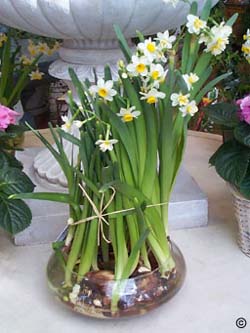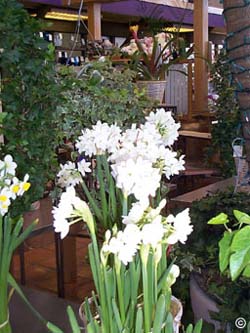
Paperwhite narcissus is one of the easiest bulbs to force for cut flowers or ornamental displays in the home from December to March. They are a form of daffodil that can be forced without a chilling period, unlike other spring-blooming bulbs like tulips and hyacinths. To force paperwhites, fill a bulb pan with about one to two inches of potting soil, and then position the bulbs in the soil so they are nearly touching each other with pointed end up. Add enough potting soil so that only the top half of the bulbs remain exposed, then water well.
Paperwhites can also be forced in shallow decorative containers with pebbles and water, or in water alone.
Place the bulb pans or decorative containers in a cool (45 – 55 degrees F) room with little or no light, to mimic being planted outside, underground. When the shoots are one to two inches tall, move the pots to a warmer location with bright indirect light. Bulbs started in a warm room have a tendency to become leggy and flop over. No fertilizer is needed to force paperwhites.

Paperwhites bloom four to eight weeks after potting. For a continuous show of color, start new pots of bulbs every couple of weeks throughout fall and winter. They bloom only once, so discard bulbs after they have flowered. Flowers will last longer in rooms at 65 – 70 degrees.
Pests and disease problems do occur in paperwhites. The most prevalent is a basal rot caused by Fusarium that infects the basal plate of the bulb and results in a mushy brown decay. Immediately discard affected bulbs. To reduce the possibility of encountering problems from basal rot, purchase bulbs that are free of blemishes and firm to the touch.
For “Bulbs: Selecting” refer to message number 1011.
For more information, see the following Planttalk Colorado™ video(s).



